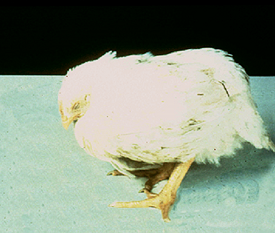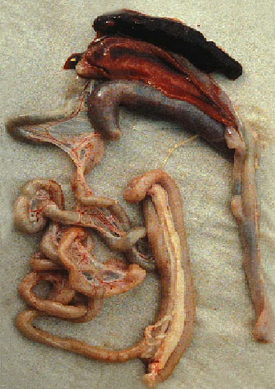Disease background
Coccidiosis is one of the most important poultry diseases worldwide and is ubiquitous, the only limit to the distribution of this disease is the distribution of the hosts.
Cause and clinical signs
A protozoal parasite which multiplies in the gut, specific to different hosts. Not all species of coccidia are harmful but there are five of the Eimeria species pathogenic to chickens, five in turkeys, three in geese, three in ducks and three in pheasants.
Enteritis (inflammation of the intestine) is present in all coccidia infections and usually accompanied by diarrhoea which may or may not have blood in it. Poor growth and impaired feed conversion is common and mortality can be increased.

Fig 1: Typical stance of a chick with coccidiosis
Transmission
Parasitic phase: the infective oocyst (coccidia egg) is eaten by the bird and then multiplies over about 7 days within the gut, thousands of new oocysts resulting from just one ingested oocyst.
Non-parasitic phase: excreted in the droppings, the oocysts then take 2 days to mature (ideal conditions 25-30ºC and moist) before being ready for the next host to eat.
There are three types of coccidia in chickens and this is reflected in the other species:
|
Type |
Species |
Area |
Effect |
|
high pathogenicity (high mortality) |
Eimeria brunetti |
large intestine |
mucoid, bloody diarrhoea |
|
|
E. necatrix |
middle small intestine |
mucoid, bloody diarrhoea |
|
E. tenella |
caeca |
clotted blood |
|
|
medium pathogenicity (low mortality) |
E. acervulina |
high small intestine |
ill-thrift |
|
E. maxima |
middle and low small intestine |
mucoid, blood-tinged faeces |
|
|
low pathogenicity |
E. mitis |
high and middle small intestine |
mucoid faeces |
|
|
E. praecox |
high small intestine |
mucoid faeces |
High pathogenic coccidia in other species:
Turkey (especially poults): E. adenoeides, E. meleagrimitis, producing watery diarrhoea and high mortality.
Duck: Tyzzeria perniciosa: producing mucoid, bloody diarrhoea.
Goose (mostly goslings): E. anseris, E.nocens producing mucoid, bloody diarrhoea. E. truncata parasitises the kidneys causing depression, emaciation, diarrhoea and high mortality.
Pheasant: E. colchici, E. duodenalis, E. phasiani, all cause enteritis and mortality.
Dayold chicks do not get immunity from their mother. Birds of any age are susceptible, but most acquire infection early in life which gives them some immunity. Immunity is best kept strong by a low level of infection, which is what happens on free-range. Birds kept or reared on litter are more at risk when the coccidia has conditions which suit it such as wet litter. If the birds are also stressed by environmental factors (cold, overcrowding, poor ventilation) then disease results. The oocysts are very resistant to destruction, either by disinfectants or by drying out and can survive for months or years.
The species of coccidia have different areas of the gut which they prefer, some producing the expected bloody diarrhoea, some producing high levels of mucus, sometimes white diarrhoea, and others stunting growth. Infection can show from 3-6 weeks of age and infective oocysts can be transported by people looking after the birds. Older birds can become infected if either their immunity has been reduced due to being kept on a wire floor (no access to droppings and therefore no trickle infection) and then put onto litter, or if environmental stressors reduce their immunity. The birds generally look hunched and depressed with or without blood in the droppings.
Economic Impact
This disease is very common and unless controlled has a severe economic impact. Even low levels of infection cause ill thrift and loss of production with increased mortality.
Diagnosis
Clinical signs plus a faecal sample containing oocysts and/or post mortem where the intestines are dark purple and the laboratory finds stages of the coccidia in the lining of them.

Fig 2: Oocysts in a faecal sample

Fig 3: Intestines with necrotic caeca
Treatment
Anticoccidial drugs in the feed for only the first 6 weeks of life which reduce but not eliminate the numbers of coccidia has been the norm in order to let the chicks have a low level of infection and therefore acquire immunity. Permitted drugs in feed are, however, being reduced on an annual basis across the board. Resistance to the anticoccidial drugs has occured.
Free-range reduces the incidence of disease while still providing trickle infection to boost immunity.
The only product currently licensed for treatment of a coccidiosis outbreak in chickens is Baycox: this use is restricted to broiler breeders on the data sheet (licence details). Sulphonamides can be ordered from specialist poultry veterinary practices. On a small scale and where the birds do not enter the food chain, the pigeon product, Coxoid, is used by fanciers and small-scale keepers. This contains amprolium which used to be licensed for chickens and has proved to be safe.
There are no products licensed for treatment in turkeys and waterfowl but Coxoid has been used with success. The coccidia life cycle is similar to chickens and the oocysts persist in the ground for months or years. Certain compounds are toxic and lethal to turkeys, particularly the ionophores such as monensin, lasalocid, salinomicin, narasin and maduramicin, therefore the label on the feed bag must be checked to avoid these.
Temperatures above 56ºC and below freezing are lethal to oocysts, as is desiccation. Oocysts can stay in sheds despite disinfection unless a specific oocidal ("egg-killing") disinfectant is used.
Vaccination
By far the better treatment and prevention for chickens is the vaccine, Paracox. This contains all seven species of coccidia but these are weakened so that they cause the chicken to mount an immune response but not to become infected. As this is an industrial product it normally comes in quantities to treat thousands of birds. Paracox is available from PHS dispensary on 01347 820366 with a prescription, in 100 and 200 dose containers. Paracox will be administered once as a solution from a dropper bottle to a healthy dayold chick via its mouth. The shelf-life of the product will be 4 weeks, so orders need to be made with the monthly expected hatch in mind. Any feed used for vaccinated birds should not contain anticoccidial drugs as this will counteract the vaccine. The vaccine can be used on unvaccinated chicks up to 9 days old but is most effective at dayold.





